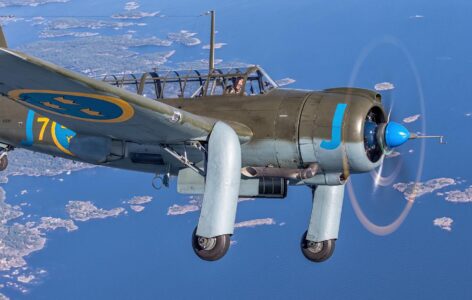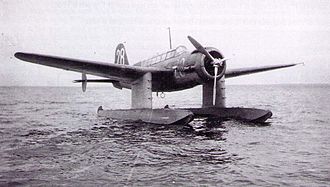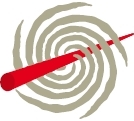På teknisk museum i Helsingør hænger der en enlig flyver af mærket SAAB med danske mærker. Problemet er at den aldrig har været i flyvevåbnet.


The Saab 17 is a Swedish single-engine monoplane reconnaissance dive-bomber aircraft of the 1940s originally developed by ASJA prior to its merger into Saab. It was the first all-metal stressed skin aircraft developed in Sweden.
B 17s in Trollhättan assembly hall in 1944
The project was initiated in response to a 1938 request from the Flygvapnet (Swedish Air Force) for a reconnaissance aircraft to replace the obsolete Fokker S 6 (C.Ve) sesquiplane. Design work began at the end of the 1930s as the L 10 by ASJA, but once accepted by the Flygvapnet it was assigned the designations B 17 and S 17 for the bomber and reconnaissance versions respectively, and it became better known as the Saab 17.
The design chosen was a conventional mid-wing cantilever monoplane with a long greenhouse canopy and a single radial engine in the nose. Control surfaces were covered in fabric but the remainder was stressed-skin duraluminum. It could be fitted with wheels or skiis, both of which retracted straight to the rear along the underside of the wing, leaving prominent fairings, and when fitted with wheels the undercarriage doors could be used as dive brakes.[3] A retractable tailwheel was provided. A floatplane version was built in small numbers for coastal reconnaissance to replace the obsolete Svenska S 5, with massive fairings joining the floats to the wings where the wheels would have been. To maintain stability small vertical fins were added to the horizontal stabilizer. The wings were reinforced so that it could be used as a dive bomber and bomb racks were provided under the wings, along with a small bomb bay below the cockpit, although some examples used a conventional rack on the centreline, while on the bomber versions, a crutch was fitted to swing the bomb clear of the aircraft in vertical diving attacks, when the bomb could otherwise have passed through the propeller. The reconnaissance versions lacked the crutch. Split flaps broken into four segments were fitted to the underside trailing edge of the wing.
Two L 10 prototypes were ordered, the first being powered by a 880 hp (660 kW) Bristol Mercury XII radial engine built by Nohab in Sweden, and the second with an imported 1,065 hp (794 kW) Pratt & Whitney R-1830 Twin Wasp C radial.
Supplies of suitable engines remained a major problem, and resulted in the aircraft being built in three versions with different engines. The definitive B 17A used the Swedish-built STWC-3 (Swedish Twin Wasp C-3), an unlicenced copy of the R-1830. The B 17B used a Bristol Mercury XXIV built by Svenska Flygmotor AB (SFA) in Sweden, and the B 17C used an imported 1,060 hp (790 kW) Piaggio P.XI radial from Italy.[4] The United States government denied a request to purchase a licence to build the Twin Wasp, so an unlicensed, reverse engineered copy was built instead as the STWC-3 (Swedish Twin Wasp C-3) to supplement and replace the lower powered Mercury radials already being built under licence.[5] Until production caught up to demand, the earliest aircraft being delivered were flown to their destinations, the engines were removed and shipped back, to be used on the next aircraft to be delivered.[citation needed]
Saab B 17B showing bombing crutch under the fuselage needed to allow the bomb to clear the propeller during a dive, and the large undercarriage doors which acted as dive brakes
The first flight was on 18 May 1940 and first deliveries of dive bombers to the Flygvapnet began in March 1942,[1] while deliveries of reconnaissance versions began in June 1942, and the type was operational by September 1942 when the first exercises were carried out.[2] Problems immediately arose with wing failures, and additional modifications were needed before it could be cleared for dive bombing, which remained limited to shallow attacks thereafter.[2] The final aircraft was delivered on 31 August 1944.[6]
A B 17 was used to test the ejection seat Saab had developed for use in the Saab 21 pusher fighter, which was first successfully fired on 27 February 1944 with a dummy.[7]
Stig Wennerström gained some fame in Sweden for successfully bailing out from a B 17 from low altitude, with his gunner, but would later become a spy for the Soviet Union.[8]
For several months in late 1944 and early 1945 fifteen B 17As were operated by the Danish Brigade in Sweden (Danforce) a unit of 5000 men (including 50 airmen) in Sweden which had been formed to assist in liberating occupied Denmark from the Nazis, and preventing the retreating German soldiers from using civilians as human shields, and carrying out scorched earth tactics as they had done elsewhere. However, due to the German surrender on 7 May 1945, the aircraft were no longer needed and were returned to Flygvapnet control a couple of months later.[9]
Rapid advances in aviation related to improved aerodynamics, higher engine power and finally the introduction of jet engines, resulted in it having a short career, and it was gradually withdrawn from frontline service between 1948 and 1950,[2] while the last examples were retired from secondary roles by 1954. Over the next few years, examples would be sold off to various operators.
Due to the efforts of Carl Gustaf von Rosen, the Ethiopian Air Force bought 47 which were operated from 1947[2] until 1968.
From 1951, 19 B 17s were loaned to Svensk Flygtjanst AB and AVIA for use as target tugs and painted yellow with civilian markings.[2] One of these, a B 17A SE-BYF was sold to the Austrian Österreichische Luftstreitkräfte in 1957, where it continued to be used as a target tug until retired in 1963. Two B 17As were also sold to the Finnish Ilmavoimat in 1959 and 1960, also as target tugs. Neither of the Finnish aircraft lasted long before being destroyed in accidents.



